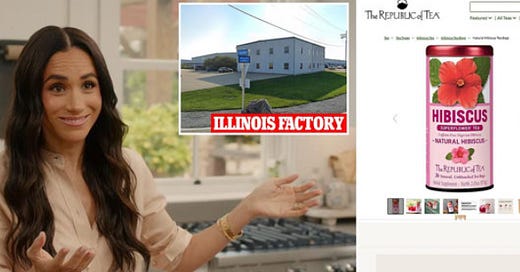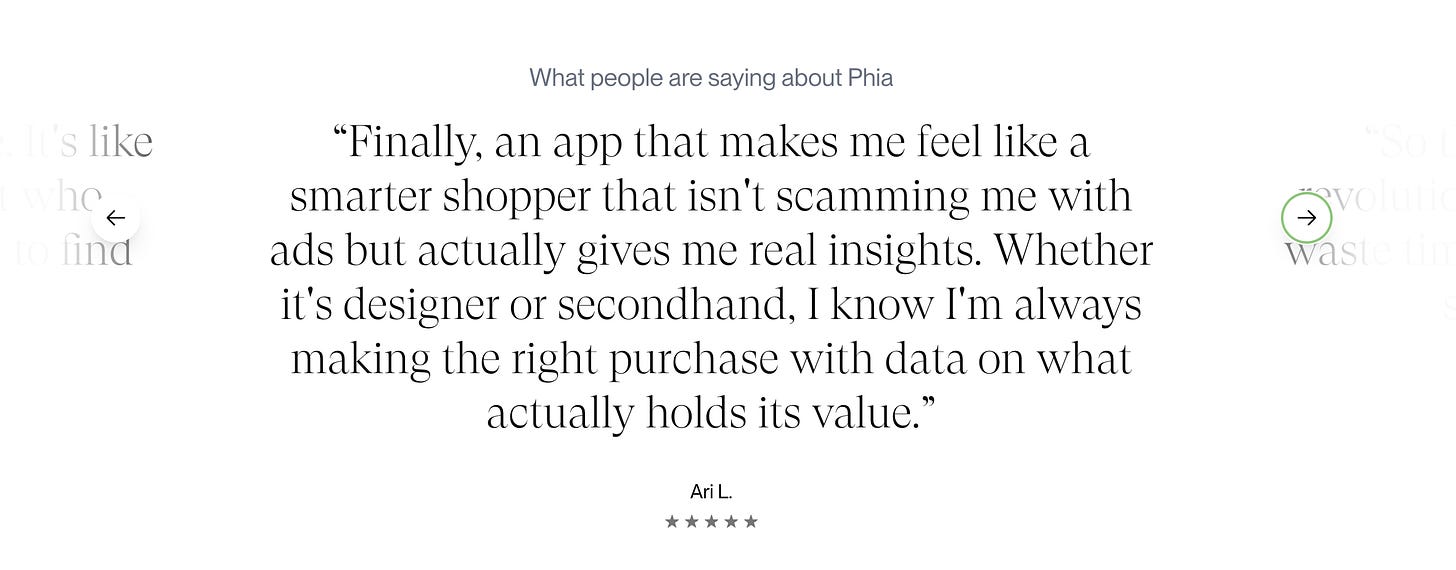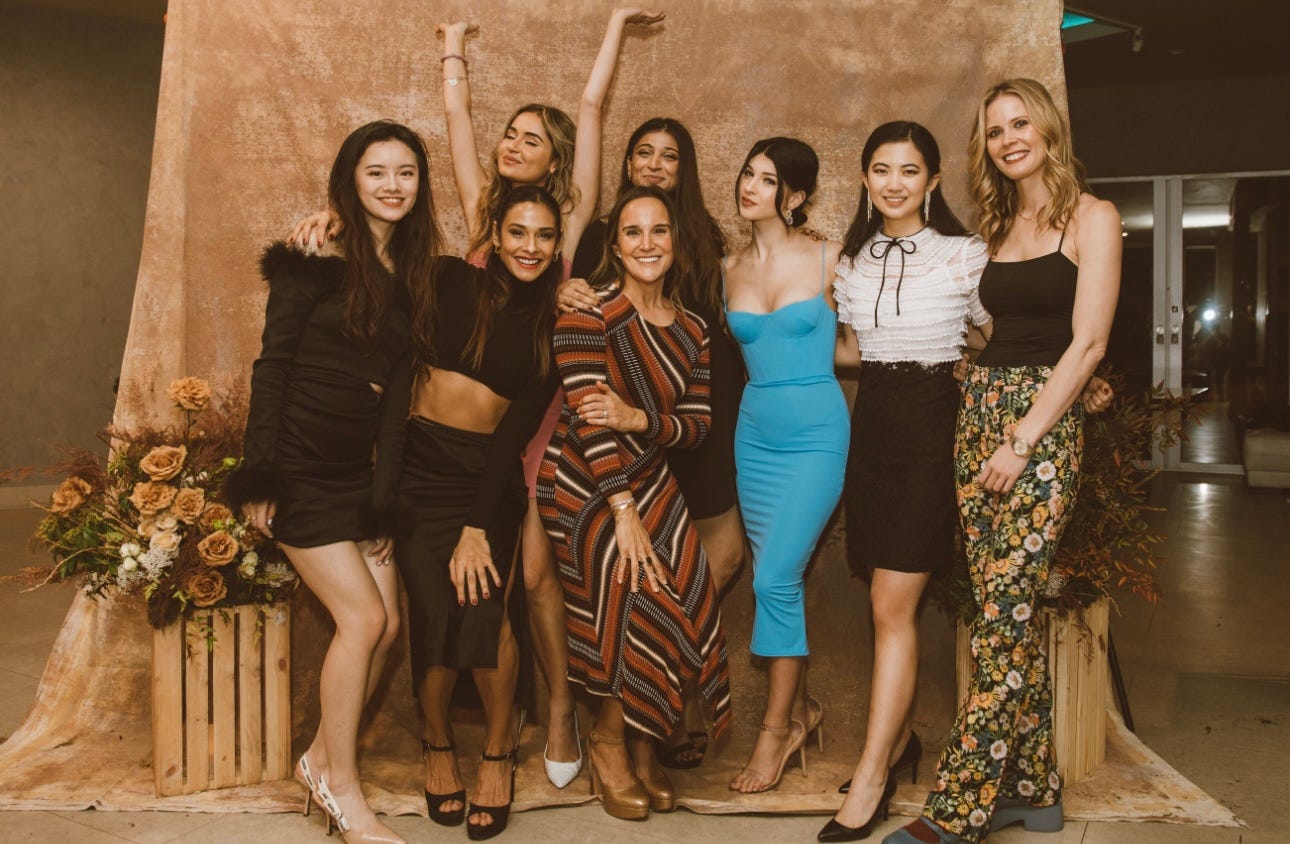The Dupe Economy: Why Today's Consumers Are Smarter Than Ever
What Phia, France, Meghan Markle, and modern knock-offs tell us about pop culture
I recently read Y2K “it girl” Rebecca Minkoff's book Fearless, which is not only filled with inspiring advice for anyone ready to start something—it's also a delightful time capsule of early 2000s culture.
While Y2K fashion may have made a massive comeback today, our relationship to technology and how we shop has changed dramatically.
It's difficult to imagine a world where “it girls” aren't on TikTok, the internet is used more like an encyclopedia than a source of entertainment, and the quality of our shopping experience is completely dependent on where you live or how far you're willing to travel to shop.
Internet shopping was in its earliest days—no Depop, no Shein, and most popular online stores we love today.
As I was reading the book, I was reminded of the scene in Serendipity when Molly Shannon tries to buy a horrific knock-off wallet for $20 on the busy streets of NYC. The wallet says "Prado" instead of Prada, but she creatively says, "For one dollar, I can buy a magic marker and fix that."
Fast forward to today—knock-offs have become dupes, duplicates that have indistinguishable quality from the more expensive, higher margin original. In some cases, a dupe is the exact same item from the same factory with the logo tag removed.
Dupes today are far from taboo; they've become a status symbol for the modern consumer who has infinite access to information. What makes someone cool today is the ability to think smarter, spend less, and not compromise on quality. If you’re covered in logos and paying full-price, the joke is on you.
While today’s educated consumer makes smarter decisions and tries their best to avoid fast fashion, it’s understandable why many young people have praised France's new law that cracks down on ultra-fast fashion carbon emissions with ad bans, eco-taxes, and transparency rules targeting SHEIN and Temu.
Fast fashion and consumer shopping trends in China have created an insatiable appetite for low-stakes, one-click buys—cheap dupes, logo-less luxury goods, items you only wear once —and it's created a lot of unnecessary waste.
But as someone who is optimistic about new technologies and trends, one thing I've loved about TikTok over the past few years is how dupe culture has enabled a new form of financial literacy and consumer savviness.
TikTok has democratized access to quality goods and ultimately unleashed a new generation of highly educated consumers who aren’t fooled by marketing campaigns and are ready to expose inauthentic and unethical companies.
For example Dupe, the visual search engine that instantly generates a list of lookalikes of the product you want for up to 90% less, is a great example of how dupe culture scales beyond fake Prada wallets to entire home renovations, office buildouts, and all types of large-scale projects.
Leveraging high-quality dupes as an interior designer could save your client tens of thousands of dollars and help you increase the margins for your business.
For small businesses with razor thin margins like restaurants, the ability to buy chef-grade knives and supplies for back of house and wine glasses, dishes, and bar supplies for front of house at a fraction of the cost can dramatically change the outcome and positioning of your business.
Element Brooklyn, an affordable alternative to your favorite soaps, candles, and home goods, very cleverly speaks to the "starter pack generation.”
The modern Yuppies who want to impress every Hinge date without spending too much money. After you've bought the real deal from Aesop, you can refill the bottle with a cheaper alternative that smells the same… because it’s better for the planet, of course ;)
For the most established, quiet luxury person who cares more about the quality of the materials over the brand name itself, Italic offers significantly discounted items coming from the same factory as the designer goods.
Italic, a company that was early to this trend and one that I invested in a little over four years ago, is a great example of outsmarting legacy retailers, empowering mom and pop manufacturing companies, and ultimately saving savvy consumers a lot of money.
Bed sheets, cashmere sweaters, diamond tennis bracelets, Japanese chef's knives—just about anything you want for your house, closet, or even your pet can be purchased directly from the same factories as Prada, YSL, and luxury brands.
For the ultra-savvy consumer, Phia is a company that displays the best possible price for an item before you buy it. It also shares the resale value to gauge how much money you can make once you’re done using it.
Phia founders Phoebe Gates and Sophia Kianni, former Stanford roommates, started building a community around Phia two years before launch as a powerful lever to bring transparency to fashion by hosting feedback sessions in their office.
They even parlayed their community mindset into a trending podcast called The Burnouts, part of Alex Cooper’s Unwell Network.
The podcast touches on the ups and downs the duo are facing as they build Phia, and it also features other female entrepreneurs and their star-studded cap table of investors including Kris Jenner and Spanx founder Sara Blakely.
From Phia’s early preview in 2023
The Business Opportunity
So what are the implications for founders of new companies and the next generation of leaders responsible for turning around legacy companies.
On a positive note, there's an opportunity to be radically transparent and build a company that's fairly priced, mindful of its impact on the planet, and checks all of the boxes for today's educated consumer.
On the other hand, this level of transparency has dramatically changed what it means to be a founder in a world where inauthenticity is almost immediately exposed.
The Opportunity: Radical Transparency Wins
Companies that embrace transparency and fair pricing are thriving. Success requires:
Honest pricing: Eliminate unnecessary markups and explain your value proposition clearly
Supply chain transparency: Show customers exactly where products come from and why they cost what they do
Quality over branding: Focus on materials and craftsmanship rather than logo recognition
Sustainability alignment: Match your environmental claims with actual practices
The Risk: Authenticity Is Non-Negotiable
Today's consumers can instantly expose inconsistencies between your company values and actual practices. Consider the backlash against Meghan Markle's company As Ever—selling white-labeled Republic of Tea products at 3x the price contradicted her authenticity-focused brand that was positioned as a small-batch, family-run business based in Montecito, California.
Three Action Steps for Your Business
Audit your value proposition: Can you clearly explain why your product costs what it does? If not, you're vulnerable to dupe competition.
Embrace transparency: Share your manufacturing process, material sources, and pricing breakdown. Consumers reward honesty with loyalty.
Focus on genuine differentiation: If your only advantage is brand recognition, you're at risk. Develop real value through superior materials, customer service, or user experience.
The Bottom Line
The dupe economy isn't killing premium brands—it's forcing them to justify their premiums. Companies that adapt by offering genuine value at fair prices will thrive. Those that rely solely on brand mystique and inflated pricing will struggle.
The consumers driving this trend aren't looking for cheap alternatives; they're demanding smart alternatives. The question for your business is: Are you giving them a reason to choose you beyond the logo?
What I’m reading
The Death of the Middle Class Musician
More and More Students are using AI to Cheat - but Does it Really Matter?













This was a phenomenal read, Brianne. It’s rare to see someone articulate so clearly what many consumers intuitively feel: we’re not in a price war, we’re in a perceived value recalibration. What you call the “dupe economy” really captures a deeper shift—consumers aren’t rejecting quality, they’re rejecting opacity, markup, and myth.
One thing I kept thinking as I read: this mindset isn’t confined to retail. Dupe culture is now moving upstream—into software, enterprise tools, and professional services. In the same way Italic offers the same materials from the same factories, we’re seeing stripped-down SaaS tools that replicate 80% of legacy functionality for 20% of the price—just without the legacy baggage. Think Notion over Confluence. Webflow over Adobe. Figma over Sketch. And in services: indie design studios over brand-name agencies, fractional CMOs over retainer-heavy firms, white-label tools replacing bloated marketing software stacks.
Even in my own world (SEO for multi-location businesses), I’ve seen this firsthand. There’s a version of $30K/month enterprise SEO that now runs leaner, faster, and more transparently—no smoke, no jargon. A dupe mindset, essentially. Bootstrapped from zero to ~$1M ARR in 2 years just by answering: what are they actually paying for, and can we deliver it without the theater?
The broader idea here is that “premium” isn’t dead—it just has to be earned differently. What consumers—and increasingly, businesses—want is a feeling of insider access without being taken for a ride. The brands (and tools, and services) that win are the ones that are smart enough to skip the logo markup and still deliver the core value.
Really appreciated this one—thank you for putting it out into the world.
— Steve Lee
This is cool to hear about. I expected when I got on the internet, it would crater the value of brand marketing as it would be so transparent what is good and valuable. The opposite has happened with news and truth in a lot of ways, and brand marketing's grips has barely changed.